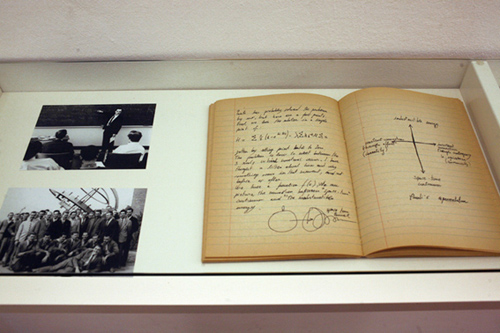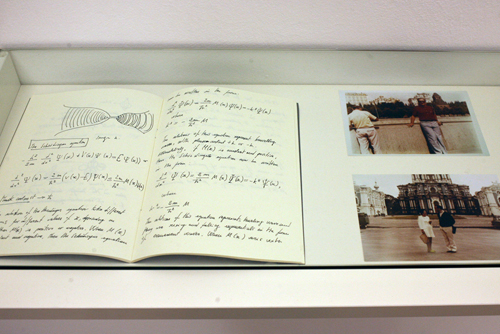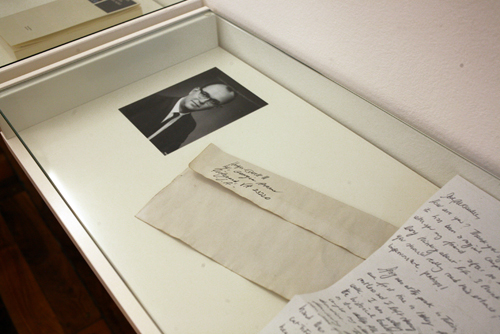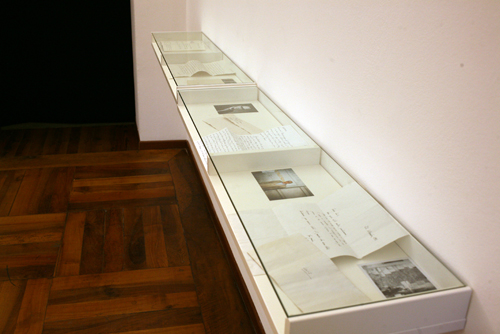Museo Caneira |la fisica del possibile
(exhibition held at Galleria Alberto Peola, Turin, 2011 | new commission)
download exhibition newsletter

Exhibition views, ©Eva Frapiccini
For the entire duration of Museo Caneira | la fisica del possible (Museum Caneira | the physics of the possible), gallery Alberto Peola is transformed into a museum dedicated to the scientist Aleksander Prus Caneira, born in Barcelona in 1928 and who disappeared under mysterious circumstances from Turin in 1991.
The foyer of the gallery becomes the front desk of the museum, providing information - both in print and digital form- on its foundation, strongly advocated by the Caneira family. To present his research on space-time tunnels, the invisible and the relationship with the Jungian unconscious, the rooms accommodate a variety of objects: a series of letters, diaries, notes and scientific journals, and a collection of unique lockets holding photographs or drawings of what the physicist defined doors to the unconscious. The objects and the finds displayed in the exhibition represent the few items rescued from an arson that, in 1992, almost entirely destroyed the scientist’s studio. Furthermore, the research and life of the scientist intertwine in a short documentary constructed through archival images, scenes of his everyday life and testimonies from his collaborators and students.
A physicist specialized in quantum and cosmic theories, an anthropologist and essayist and the founder and editor of the science journal Source, Aleksander Prus Caneira – a rather tormented genius figure – studied between Zurich and Princeton and contributed to the research of his famous professors, namely Wolfgang Pauli, Eugene Wigner and John Archibald Wheeler. He was a friend and collaborator of the physicist Hugh Everett III, and of the Jungian psychologist Marie-Louise Von Franz. He also held a lengthy mail correspondence with the writer Jorge Luis Borges.
Caneira taught at Princeton, as well as Zurich and Turin, where - between 1965 and 1976 - he was active as a researcher in the teams of the Cosmic Physics Centre and CNR. His theories on the doors of the unconscious and on suspended portals - largely despised by the international scientific community - caused him to gradually distance himself from academia, until his final resignation from teaching in 1976. Since the death of his father in 1953, Caneira had been widening the scope of his studies on the invisible, trying not only to find answers to questions typical of quantum and cosmic physics, but also to locate a nexus between space-time and dreams, archetypes, and with the passage from life to death through the anthropological and his own field research. By originally applying a series of concepts to such phenomena - for example Jung-Pauli’s synchronicity, Everett III’s theory of parallel worlds, and Wheeler’s geometrodynamics - under the pseudonym Alek Arencia, in 1987 he published the successful essay Life in the other word.

Eva Frapiccini, From the series: Portals, 2011 - Obj. Nr.01 – Barcelona, Plaça Sant Felip Neri, 1932. (courtesy: the artist and Galleria Alberto Peola, Turin).
Museo Caneira | la fisica del possibile proposes a meta-reality: it is a real exhibition hosting a physical and psychological space from which the viewer will exit unknowingly tricked, not knowing – unless he/she decides to dive deeper into the case and verify the sources (or had perhaps read this press release, only distributed digitally) – that the museum itself is dedicated to someone who never actually existed but whose story is firmly anchored in the last century’s history of science and culture. In the imagination of the artist, writing often in collaboration with the curator, there emerges the creation and characterization not only of Aleksander Prus Caneira - the man and the scientist - but also of characters and elements that determine his nature, his behaviour, and which influence his research. In so doing, Frapiccini strongly criticizes not only the logic behind the production of history, inserting a character who could have actually existed and been “forgotten”, but aims also at discussing the validity of sources, our way of relating to our cultural History, and what could be truly considered auctoritas – as in Stanza, 2010.
Museo Caneira | la fisica del possibile is a body of work that parts from the artist’s oeuvre only in its being fiction rather than History or current chronicles. Frapiccini’s work is often characterized by a poetic reading of the places and their deeper connections with History as well as the trivial or major dramatic occurrences in society and everyday life. The photographs encased in the lockets of Museo Caneira are doors of the unconscious, just as the locations of the attacks portrayed in Muri di Piombo, 2005-2007: they are synchronic spaces, in which the artist, following scientific rules for the definition of space-time coordinates, depicts the spot of passage, the point of access to another world which does not necessarily signifiy death. The portal is often a real place alluding to symbolic one. A place where humans can, despite the odds, find a different world and a normal life – as seen in Container Sweet Container (2009) and 106 Statale Ionica (with Filippo Romano, 2008-2010) – and can also dream, getting more in touch with themselves – as has been seen in the artist’s work Weaned/Svezzati (2011).
Exhibition views, ©Eva Frapiccini






























The Artist : Eva Frapiccini
Statement
Eva Frapiccini’s artistic practice, aiming at questioning her own cultural identity, and that of a few generations spanning from the 1940s to the 1980s, operates through a process of systematic research and analysis of archival materials (images, films, objects and texts), as well as directly collecting testimonies. The field of study, rather broad, is that of tracing our collective memory.
By taking documents out of their original contexts to tell a new true story, or by creating believable fictional characters with their own apparatuses of fake documentation and specimens, the artist appropriates the medium of recent history and socio-cultural developments, as well as art history, literary history and the history of science, to deconstruct the reliability and the ethics behind our systems of knowledge and belief, and unmask “sacred” spaces, like the media, libraries and museums, to attempt a new definition of what could be truly considered "auctoritas". Each piece takes a concept as well as context-specific format, so that Eva’s practice moves harmoniously from advertising campaigns to dance performances, from photography to sound installation, from public art intervention to sculptural installations, from film to exhibition making. Her practice is very often collaborative, and she works in dialogue with different practitioners (curators, graphic designers, architects, choreographers, and so on), yet maintaining an authorial position towards her works.
Currently, she is focusing on a research project exploring the borders of collective imaginaries in different cultures, through the imagery offered by dreams. Stemming from an interest in the Jungian theory of the Collective Unconscious, she aims to trace the changes of archetypical images in people’s dreams, by collecting audio recordings of dreams in different cities worldwide through the travelling project Dreams’ Time Capsule. As it is important to her to always collect first-hand testimonies to give an edge to the work, making it “more human”, the time capsule, and the residency format (Eva will be at Townhouse, Cairo, in the Spring, for instance) are very useful tools for her to collect a rich archive of experiences from different cultures, which she will then study comparatively, ten years after the closure of the Dreams’ Time Capsule. Other strands of this research, besides dreams, are folktales and popular customs, which the artist considers the three fundamental elements at the very basis of the shaping of any collective imagery, and therefore collective memory.
Bio
Eva Frapiccini (born 1978) lives and works between Turin (IT) and Rotterdam (NL). She earned her BA and MA in Art History from the University of Bologna, and a BA in Photography at Turin’s IED. In May - July 2012, she will be the selected ResO’ artist in residence at Townhouse Gallery in Cairo; between February and June 2011, she was artist in residence at NAC Foundation in Rotterdam. She is represented by Galleria Alberto Peola, Turin, since 2009.
Her works are included in a number of institutional collections in Italy, such as GAM and Fondazione Sandretto Re Rebaudengo, Turin; MAMbo, Bologna; Fondazione Fotografia Modena e Cassa di Risparmio Modena, Modena; as well as in private collections. She has been awarded many prizes, amongst which Special Italia Prize, Fondazione Fotografia Modena (2010); Passport for Art Prize, Unicredit & Art (2005); Pesaresi / Contrasto Prize (2005); Canon Prize (2004). In 2008 Skira published the bilingual monography Muri di Piombo. Eva Frapiccini.
Solo exhibitions include Museo Caneira | la fisica del possibile (curated by Elisa Tosoni, Galleria Alberto Peola, Turin, 2011), Thank you for coming (Around the Corner Project Space, and public space in Rotterdam, 2011); Muri di Piombo (curated by W. Guadagnini, Spazio Milano UniCredit, 2008) and Muri di Piombo (Museo Diffuso e della Resistenza, Turin, 2008).
Her work has been included in the 12th Architecture Biennale (curated by L. Molinari, Padiglione Italia, Venice); Rencontres Internationals de Photographie (Arles, 2008); PhotoEspana (Madrid, 2006); Festival Internazionale di Fotografia di Roma (Museo Trastevere, Rome, 2006) and the screenings Art of Inexperience (curated by S. Menegoi, KIM? Contemporary Art Centre Spikeri, Riga, 2011), Invisible Blindness (curated by A. Spinelli, Mkhitar Sebastatsi Educational Complex, Yerevan, 2010). Amongst the many group exhibitions: Angry, Young and Radical (Nederlands Fotomuseum, Rotterdam, 2011); ON.Luci di Pubblica Piazza (curated by A. de Manincor, M. Angelotti, Piazza Verdi, Bologna, 2011); Ricerca tra le righe (curated by Gruppo START, Biblioteca di Lettere, Università di Torino, 2010); TRE (curated by F. Maggia, Fondazione Fotografia Modena, Modena, 2010); GE09 - 1999-2009, Dieci anni di fotografia (curated by F. Maggia, Sandretto Re Rebaudengo, Guarene d’ Alba, 2009); Eppur Si Muove (curated by I. Guerrero, J. Kläring e P. Vermoortel, Palazzo Ducale, Genoa, 2009); Les Rencontres d’ Arles “Chouchou” (Farmani Gallery, New York, 2009); Pezza European Photography Prize (Museo di Fotografia Contemporanea, Milan, 2009); Focus on Contemporary Italian Art (curated by G. Maraniello, MAMbo, Bologna, 2008); Pazi Mine (Fondazione Sandretto Re Rebaudengo, Turin, 2007); Mutation I (Museum Auf Abruf, Vienna; Museo Bilotti, Rome; House of Photography, Moscow, 2007) and (Maison de la Photographie, Paris; Casino Luxembourg, Luxebourg; Martin Gropius Bau, Berlin and Bratislavsky Hrad, Bratislava, 2006); GE06 Da Guarene all’ Etna 06, (Fondazione Sandretto Re Rebaudengo, Guarene d’Alba, 2006); Pesaresi Prize, (Si Fest, Savignano sul Rubicone, 2006); Nuovi Arrivi 11 (curated by O. Gambari, Accademia Albertina delle Arti, Turin, 2005).